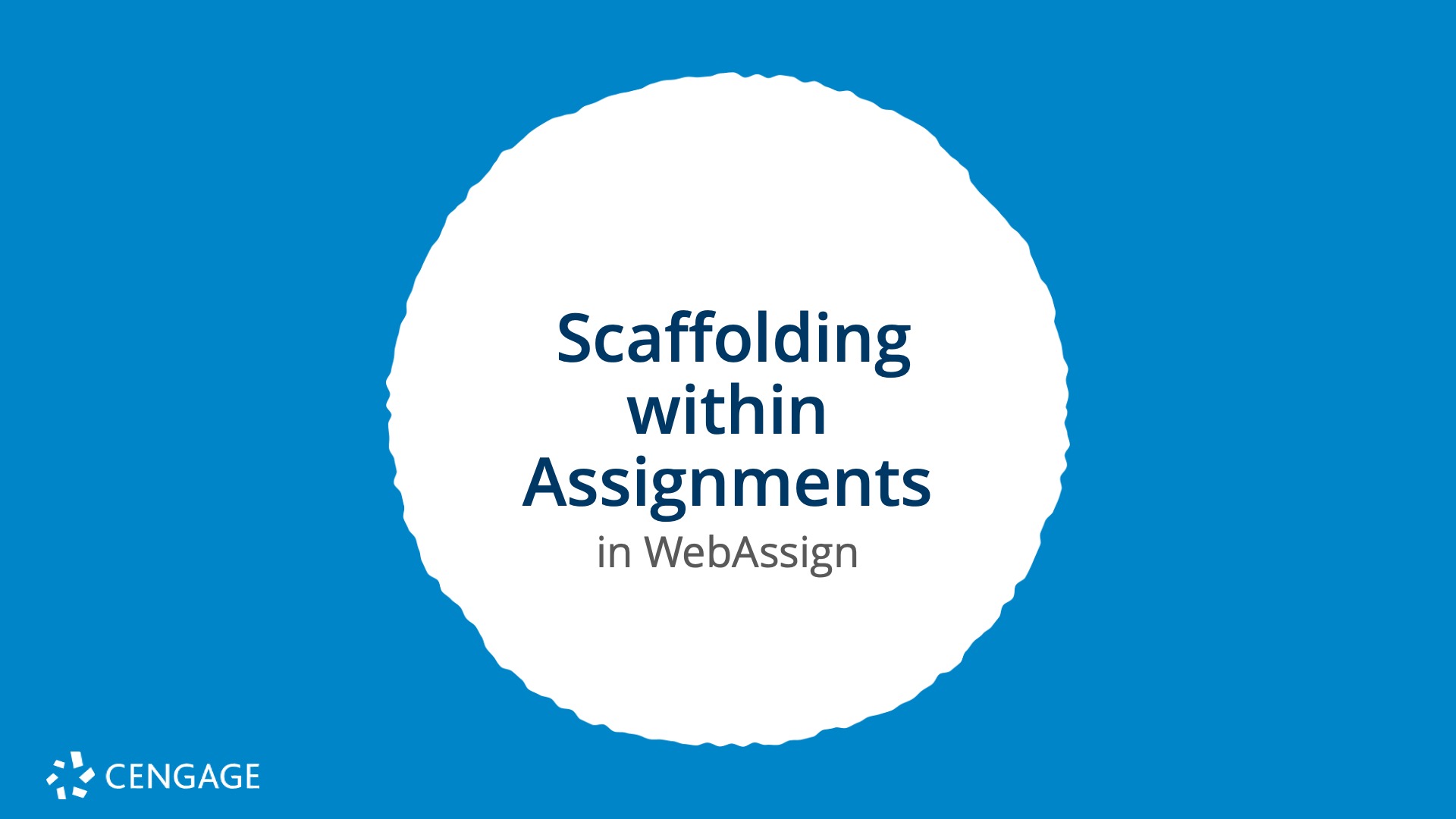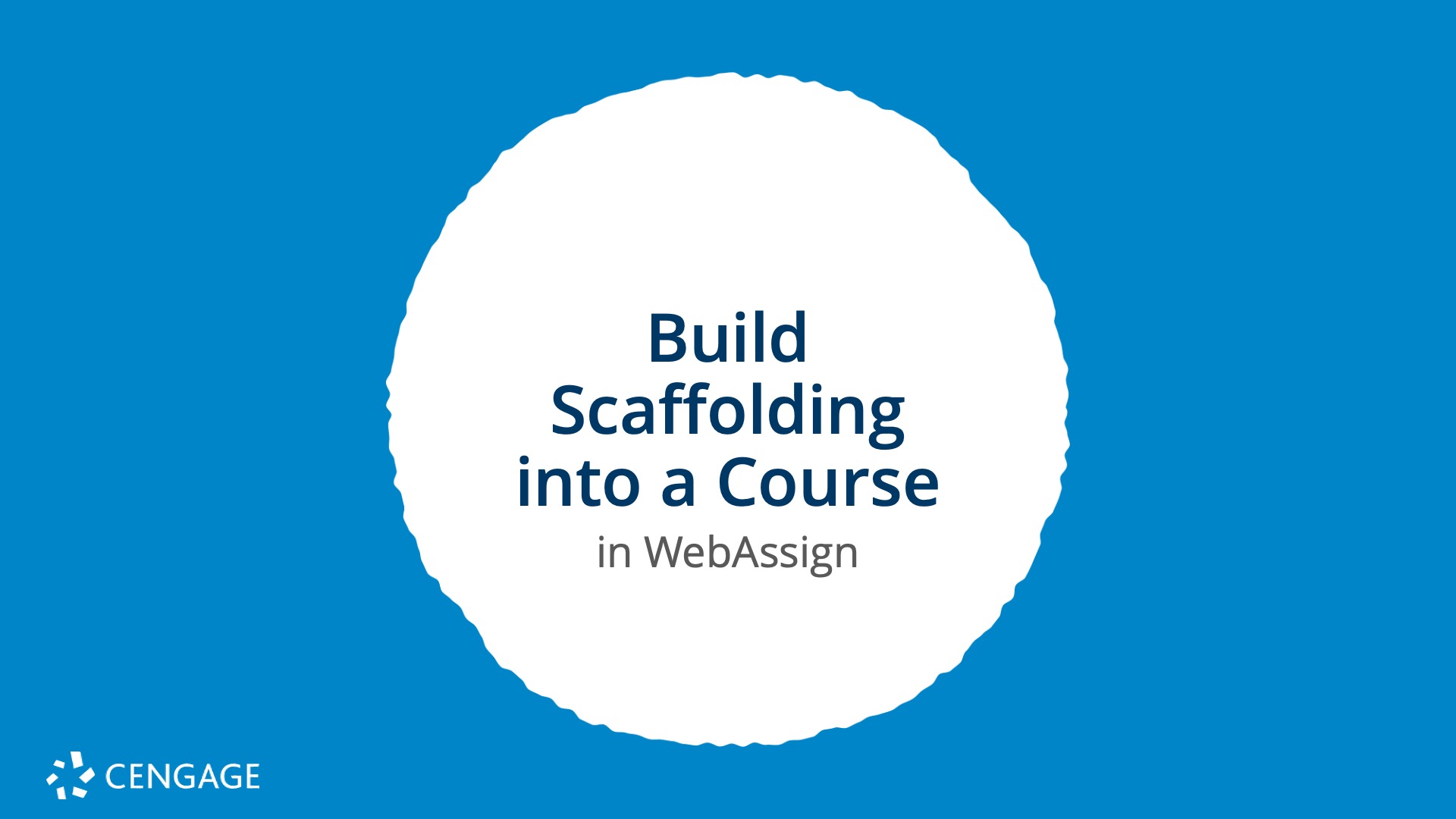According to EdGlossary, scaffolded instruction refers to a variety of teaching techniques used to move students progressively toward a stronger understanding and greater independence in the learning process. Instructors provide temporary support or resources that help students gain skills and improve their understanding. Then, the supportive resources are slowly removed as they are no longer needed, and the instructor gradually shifts more responsibility over the learning process to the student.
How can scaffolded instruction be applied to your course in WebAssign? Let’s explore techniques discussed during Fisher College Professor Willem Wallinga’s presentation Dealing with the Learning Gap to help you transform your WebAssign course with scaffolded instruction.
1. Use an Advanced Module Design to Build Self-Sufficient Learners
As you embark on scaffolding, always start with a strong structure. Professor Wallinga recommends using an Advanced Module Design. A “module” refers to anything you may think of as an assignment which includes homework, laboratory problem sets, review and self-guided practice, summative assessments or even projects. This breaks down your course design into three core steps:
- Select a Learning Objective: You’ll always start with a course learning objective. For example, apply common techniques for factoring algebraic expressions. Modules typically focus on only one learning objective.
- Determine Your Course Content: Identify the topics within each learning objective. For example, greatest common factor, difference of squares, trinomials and grouping all need to be understood in order to achieve the above learning objective.
- Complete Your Module: Select questions from a variety of sources that cover each of the topics. When you’re ready to select your questions and set up your module, you’re going to apply scaffolding to identify and resolve knowledge gaps.

2. Delivering Scaffolding to Students within Assignments
Once you have your learning objective and course content, you’ll be able to construct an effective, scaffolded module using these techniques. In Dealing with the Learning Gap, Professor Wallinga demonstrates how to transform typical word problems with scaffolded instruction to increase student understanding using tutorial questions.
Begin with Tutorial Questions
Start each module by introducing students to the new topic using tutorial questions. Tutorial questions will break down the learning process to help students better understand the necessary steps it takes to solve the problem. Here are a few tips:

- Begin your assignment by selecting multi-part problems such as tutorial questions. In WebAssign, tutorial questions are in incorporated in a variety of different question types such as Master It Tutorials – Standalone (MI.SA) or Concept Checks (.CC). These problems will require students to answer each step in the problem-solving process.
- Follow these questions with another tutorial with fewer steps to get to the correct answer, or a question with an optional tutorial such as an Expanded Problem (.EP) or Master It tutorial (.MI), available as learning support. These tutorials will only require students to complete the final answer, but also give them the step-by-step problem should they need additional support.
- To find these questions, search the question abbreviation (i.e.: “MI.SA”) in the question browser.
Tutorial questions help to close readiness gaps by walking students through problems step by step. They also add a layer of academic integrity to ensure students understand how to solve the problem rather than just look up the answer.
Slowly Remove Learning Support and Resources
As you scaffold your assignment, you’ll want to consider: How much guidance are you interested in giving? How much can your students handle? When students see a topic for the first time, you want to make sure they have that support and guidance available to them along the way. At the beginning of the assignment, make learning tools available—such as Read Its, Watch Its and Master Its—as optional resources to help your students if they get stuck.
Then, as students progress through the module, slowly remove the support so eventually they are responsible for solving the problem independently. For example, you may choose questions with an abundance of learning support (Read Its, Watch Its, Master Its) toward the beginning of the assignment then follow it with a question that only has a video resource.

End with Assessment Questions and Show my Work
Now it’s time for students to solve the problem independently and, if necessary, demonstrate the work they completed to do so. After students have encountered step-by-step tutorials and resources, they should be ready to apply their knowledge without assistance. At the end of the assignment, you’ll want to ensure students understand the topic with an answer blank without any learning support, tutorials or resources. You can also enable Show My Work to ensure they truly understand the final topic by having them upload or annotate their thinking.
With scaffolding in assignments, you want to see evolution. You’ll want to start a new topic with heavy scaffolding—tutorials and support—then slowly remove that scaffolding to move students through the learning process. In addition to scaffolding your assignments, you can also rethink how you deliver your course to students with scaffolding techniques.
3. Build Your Course with Scaffolding
A scaffolded course applies all the techniques we just learned but delivers them at a greater scale within your course. Professor Wallinga takes a three-step process to creating a scaffolded course, which he applies to his learning objectives. Even if you’ve already built your course, you can still apply scaffolding to your existing course.

Professor Wallinga breaks each unit into three distinct assignments:
- Preview assignment: This assignment is due before the class meets and covers basic topics and definitions. It’s intended to remind students of the vocabulary and sometimes has optional tutorials should the students want to get some practice in early.
- Practice Set: Each week Professor Wallinga schedules a homework assignment applying the scaffolding techniques from above. The assignment begins with a tutorial, optional resources and videos. Then it ends with an assessment question and the ability for students to show their work.
- Quiz: Due at the end of the week, students are quizzed on the topics covered in the practice set. The quiz doesn’t include any scaffolding—it’s pure assessment. Professor Wallinga also gates the assignment with conditional release, so if students achieve higher than an 80% on the practice set, they can access the quiz early. This motivates students to avoid waiting until the last minute to finish their practice set. If students wait or don’t achieve an 80%, the quiz opens automatically on Friday morning.
This is just an example of one of the many ways scaffolded instruction enhances the student learning experience. Keep in mind that Course Packs are also available to make this process easier for you.
Key Takeaways
- Use learning objectives as your guide to construct modules.
- Personalize content to the learning trajectory of your students. Some students may need more help than others.
- Use incremental scaffolding techniques to represent the “big ideas.” If you have a big topic, be sure to add scaffolding to break it down further to make sure your students understand it.
- Keep students engaged by using multiple question types—avoid that textbook monotony by making every question different.
Watch the full webinar recording of Dealing with the Learning Gap presented by Willem Wallinga.

